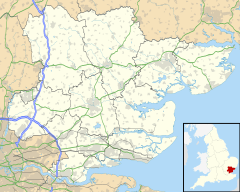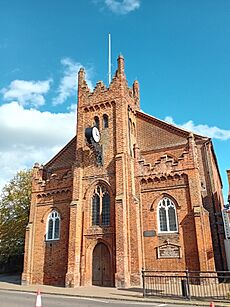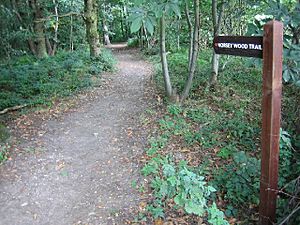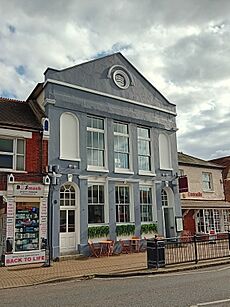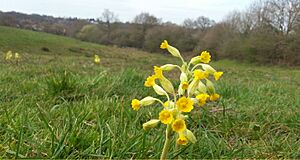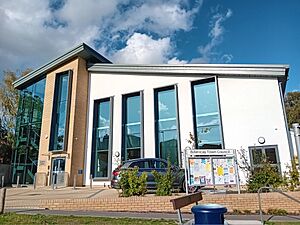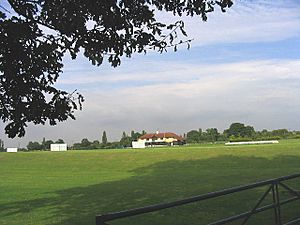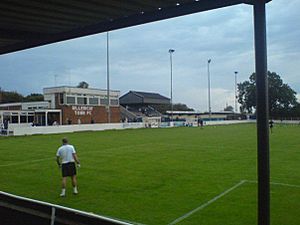Billericay facts for kids
Quick facts for kids Billericay |
|
|---|---|
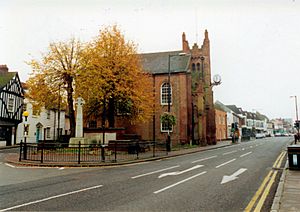 Billericay High Street and St Mary Magdalen Church |
|
| Population | 28,558 (Parish, 2021) 31,275 (Built up area, 2021) |
| OS grid reference | TQ675945 |
| Civil parish |
|
| District |
|
| Shire county | |
| Region | |
| Country | England |
| Sovereign state | United Kingdom |
| Post town | BILLERICAY |
| Postcode district | CM11, CM12 |
| Dialling code | 01277 |
| Police | Essex |
| Fire | Essex |
| Ambulance | East of England |
| EU Parliament | East of England |
| UK Parliament |
|
Billericay (pronounced BIL-ə-RIK-ee) is a town in Essex, England. It's located about 23 miles (37 km) east of London. The town was started in the 1200s by the Abbot of West Ham.
A big event in Billericay's history was the Peasants’ Revolt in 1381. The Essex rebels fought against King Richard II's army here. In 1620, four people from Billericay sailed on the famous ship, the Mayflower. They went to America to help start the first English settlement in what is now Massachusetts. Billericay is very proud of this connection. Many local businesses and groups use the name Mayflower as a symbol.
Contents
What's in a Name?
The name Billericay has a bit of a mystery! It was first written down as "Byllyrica" in 1291. The town was built in the 1200s in an area that already had many people living there.
People have a few ideas about where the name came from:
- Villa Erica: This means 'Heather Villa' in Latin. It suggests the town might have Roman-British roots.
- bellerīca: This is a medieval Latin word for 'dyehouse or tanhouse'.
- billers: This is an old name for watercress. Watercress was grown in Billericay's springs even in the 1900s.
There are other places in England with similar names, like Billerica in Kent. This place was near a Roman fort, which makes the idea of a Roman name more likely.
History of Billericay
Early Times
We know people lived in Billericay a very long time ago. There are old burial mounds in Norsey Wood from the Bronze Age and Iron Age. These show that people lived here thousands of years ago.
Evidence of a Roman town was found near Billericay School. This town was later abandoned. There might have also been a small Roman cavalry fort at Blunts Wall Farm.
The Middle Ages
The town of Billericay began in the 1200s. It was part of a larger area called Great Burstead. The Abbot of West Ham, who was the head of a group of monks called Cistercians, founded the town. His abbey owned the land of Great Burstead.
Billericay was built on high ground, which was a good spot. It was also at an important crossroads. One road went from the River Thames to Chelmsford. The other linked Hutton to Wickford.
At first, the main church for Billericay was in Great Burstead. Later, a small chapel was built in Billericay. This chapel eventually became a parish church in 1844, also called St Mary Magdalen.
In the 1200s and 1300s, some pilgrims traveling to Canterbury passed through Billericay. They might have stayed overnight in the town before crossing the River Thames. This could be why Billericay had many inns.
The most famous historical event in Billericay was the Battle of Billericay in 1381. This was during the Peasants' Revolt, when ordinary people rose up against the king.
Tudor Times
During the Tudor period, some people in Billericay were influenced by new religious ideas. Four local people were sadly executed for their Protestant beliefs during the reign of Queen Mary. Two others were tortured.
The Pilgrim Fathers
It is believed that the Pilgrim Fathers met in Billericay before they sailed on the Mayflower. Many local names and symbols in Billericay remember this connection. For example, there's Mayflower House, Mayflower School, and Mayflower Hall.
Christopher Martin was born nearby and lived in Billericay. He sailed on the Mayflower in 1620. He was the ship's official governor and bought supplies for the journey.
The Mayflower set sail to meet another ship, the Speedwell. But the Speedwell had problems and couldn't make the trip. So, the Mayflower sailed alone from Plymouth.
Four people from Billericay were on board: Christopher Martin, his wife Mary Prowe, her son Solomon Prowe, and the Martins' servant, John Langemore. Sadly, all four died after arriving in America. Christopher Martin died in January 1621, and his wife died later that year. They are buried in Plymouth, Massachusetts.
Even though it was a tough start, other people from Billericay later sailed to the New World. The town of Billerica, Massachusetts, in America, was founded in 1655 by colonists from Billericay and named after their old home.
Georgian and Victorian Eras
In the 1700s and 1800s (the Georgian period), many beautiful houses were built in Billericay. Burghstead Lodge on High Street is one example. The Town Hall was built in 1830.
The railway came to Billericay in 1889. The station is on a line that connects Shenfield and Southend-on-Sea.
The 1900s
During the First World War in 1916, a German Zeppelin airship was shot down over Billericay. It crashed near the High Street. A plaque was put up in 2016 to remember this event. Parts of the Zeppelin's frame can be seen at the Cater Museum in Billericay.
The old workhouse building in Billericay became St Andrew's Hospital. This hospital had a famous unit for plastic surgery and burns. It moved to Chelmsford in 1998. After that, most of the hospital area was turned into homes.
Geography
Parks and Open Spaces
Billericay has two main parks: Lake Meadows and the Queen Elizabeth 2nd Playing Field, also known as Sun Corner. There are also smaller green areas in the town.
On the edge of town, you'll find more open spaces. Hannakins Farm has playing fields. Queens Park Country Park is a nature reserve. Norsey Wood and Mill Meadows are also nature reserves. They are like 'green wedges' that stretch from the countryside into the town.
Both Mill Meadows and Norsey Wood are very important for nature. They are protected areas because they have rare wild flowers, fungi, insects, and other creatures. Mill Meadows, for example, has special grassland that is home to many unique species.
Nearby Places
Some towns and villages near Billericay include Stock to the north, Ramsden Heath to the east, Basildon to the south, and Brentwood to the west.
Land and Soil
Billericay is in an area called the London Basin. The ground here is made up of different types of clay and sand. Where the soil changes from sandy to clay, you often find natural springs.
How Billericay is Run
Billericay has three levels of local government:
- Billericay Town Council: This council looks after local town matters. It has its office at the Chantry Centre. Since 1998, the Town Council has had a "youth town council" scheme, where students from local schools are elected to learn about local government.
- Basildon Borough Council: This council covers the wider Basildon area, including Billericay.
- Essex County Council: This council looks after county-wide services like education and roads.
Parliamentary Representation
Since 2010, Billericay has been part of the Basildon and Billericay parliamentary area. The person who represents this area in the UK Parliament is Richard Holden.
Getting Around
Many people who live in Billericay travel to London for work.
The town has Billericay railway station. Trains run from here to London Liverpool Street, Shenfield, and Southend Victoria.
Local buses connect Billericay to nearby towns like Chelmsford, Basildon, and Brentwood. The main roads in Billericay are the B1007 and the A129. These roads link the town to other areas and to bigger roads like the A12 and the A127.
Schools
Billericay has several schools, including:
- Billericay School
- Mayflower High School
- St John's School
Sports and Clubs
Billericay has many sports clubs:
- Billericay Town Football Club (soccer)
- Billericay Rugby Football Club (rugby)
- Essex Spartans (American football)
- Mayflower Archers (archery)
- Billericay Striders Running Club (running)
Twin Towns
Billericay is twinned with towns in other countries. This means they have a special friendship and exchange programs.
- Fishers, Indiana, United States (since 1998)
- Billerica, Massachusetts, United States (since 1998)
- Chauvigny, France (since 2005)
Famous People from Billericay
Many notable people have connections to Billericay, including:
- Neal Asher, science fiction writer
- Francis Thomas Bacon, engineer
- Lee Evans, comedian
- Mark Foster, swimmer
- David Gandy, model
- Christopher Martin, Mayflower pilgrim
- Alison Moyet, pop singer
- Richard Osman, TV personality
- Paul Parker, footballer
- Russell Tovey, actor
- Ben Wheatley, film director
Images for kids
See also
 In Spanish: Billericay para niños
In Spanish: Billericay para niños


